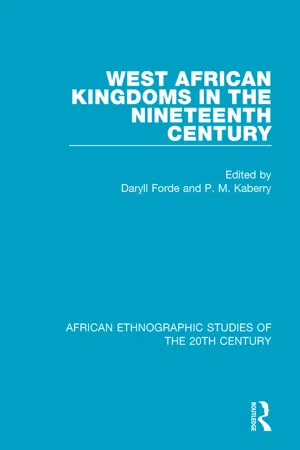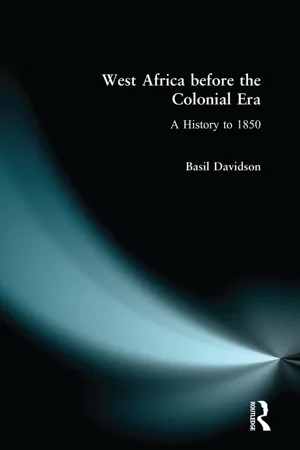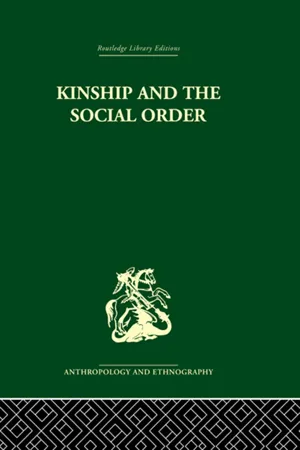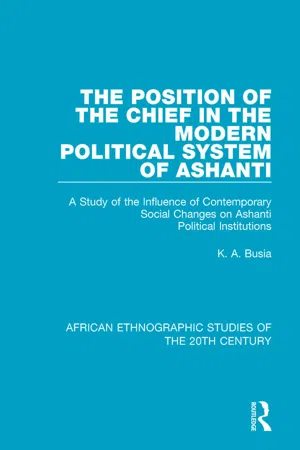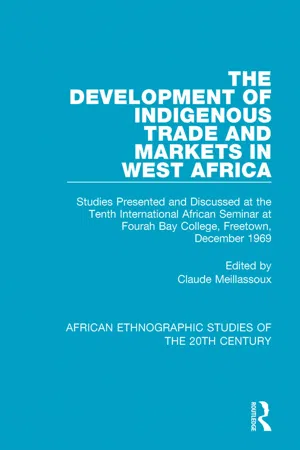Ashanti Empire
The Ashanti Empire was a powerful West African state known for its wealth, military prowess, and sophisticated political system. It emerged in the 17th century and was centered in present-day Ghana. The empire's economy was based on gold mining and trade, and it played a significant role in the trans-Atlantic slave trade.
7 Key excerpts on "Ashanti Empire"
- eBook - ePub
- Daryll Forde, P. M. Kaberry, Daryll Forde, P. M. Kaberry(Authors)
- 2018(Publication Date)
- Routledge(Publisher)
...In the south Ashanti dominated the Guinea Coast at least from Cape Lahu (Ivory Coast) in the west to Little Popo (Togo) in the east (Dupuis, 1824: xli; M’Leod, 1820: 140). On a conservative estimate, Ashanti had established its ascendancy over an area of some 125,000–150,000 square miles, from the southern coasts through the high forest, heartland of the empire, and far into the northern savannahs. Within this area there lived probably between three and five million people. 6 Economically the territory was rich in exploitable natural resources, especially of gold and kola. Along ancient trade-routes to Hausaland in the north-east, and to Timbuktu and Jenne in the north-west, Ashanti commodities could pass into the entrepôts of the Western Sudan and some, by the trans-Saharan caravan trails, on to the greater markets of North Africa. On the southern shores of Ashanti the agents of Danish, Dutch, English, and French companies had established their numerous factories, and vied with each other, and with the northern merchants, for the trade of the interior. Through the ramifications of the distributive trade, the Ashanti economy became linked with those of Europe and North Africa, responsive to the changing patterns of supply and demand in world markets. The size and complexity of the Ashanti Empire in its developed state posed problems of organization of a quite different order from those that had faced the early kings...
- eBook - ePub
West Africa before the Colonial Era
A History to 1850
- Basil Davidson(Author)
- 2014(Publication Date)
- Routledge(Publisher)
...What weakened the Asante, later on, and brought the eventual downfall of this big empire, was the repeated clash with British invaders from the coast. Yet for more than 100 years the Asante dominated most of the country of modern Ghana, some of the inland country of the Ivory Coast, and parts of modern Togo. Here they succeeded in building another large and unified system of government and trade such as had existed earlier in the Western Sudan – under Ancient Ghana, Mali, Songhay, Kanem-Bornu – or under Benin and Oyo in the east. All important rulers in West Africa recognized the strength and dignity of the Asantehene. Ambassadors went back and forth between them. Muslim clerks and teachers accompanied the Dyula and Hausa traders down the routes from Kano, Kong, Jenne and other states and cities of the Sudan. They were welcomed in Kumasi and other centres of the empire, and were invited into the service of the Asantehene and his government. In the nineteenth century, if not earlier, Muslim clerks were regularly employed to keep the records of the central government, and to conduct its official correspondence with foreign governments. Trade continually expanded. There were constant exchanges of ideas and information between Asante and other African states. Asante, Fante and Britain Southward along the coast of modern Ghana, the power of the Asantehene was well known to the Europeans in their castles, and, through them, to the courts of European kings and the boardrooms of European and American banks and trading companies. But here in the south there were some contrary developments. The Dutch and British in Ghana now became an important factor in African plans and policies. Denkyira, and then Asante, had made a trading partnership with the Dutch at Elmina and at one or two other forts. But the Asante and the Dutch were not the only partners in this business...
- eBook - ePub
Kinship and the Social Order.
The Legacy of Lewis Henry Morgan
- Meyer Fortes(Author)
- 2013(Publication Date)
- Routledge(Publisher)
...The foundation of this wealth, and of the political and military power it supported and displayed, was, of course, not the subsistence economy but the gold won in part from the soil, in part from tribute, and the kola nut for which the forest zone was famous. 11 Though they lacked the art of writing, 12 the Ashanti achieved a sophisticated level of statecraft. 13 They had a complex machinery of government and administration based on the king’s capital and linked to a nationwide system of judicial institutions that culminated in the sovereign authority of the king. A hierarchy of palace officials whose appointment was firmly controlled by the king conducted the fiscal affairs and the foreign commerce of the Kumasi chiefdom and thus, indirectly, of the nation, and supervised the intricate organization of the court and capital. Other high-ranking offices were connected with the military organization of the state, the maintenance of communication with the regional chiefdoms, and the implementation of the king’s authority and prerogatives throughout the realm. These offices of the king’s chiefdom, augmented when major issues of policy and war came up by the chiefs and councillors of the associated chiefdoms to form a national assembly, constituted the advisory and judicial councils without whose concurrence the king could not legitimately act in national affairs. To diversification by rank, wealth, occupation, and locality was added the very important differentiation of status between the freeborn citizens and the subjects who were themselves, or were descended from, war captives, refugees, and others of slave or alien status...
- eBook - ePub
The Position of the Chief in the Modern Political System of Ashanti
A Study of the Influence of Contemporary Social Changes on Ashanti Political Institutions
- K. A. Busia(Author)
- 2018(Publication Date)
- Routledge(Publisher)
...CHAPTER V THE ASHANTI UNION Character and purpose of the Union T HE tradition is that the Ashanti States formed a Union in order to fight for their independence against Denkyira, to which they were tributary. At that time the States lived close to one another near Sante-manso, whence they subsequently moved into other areas. The picture presented is that of a segmentary political system in which the segments or States, possessing similar social and political institutions, a common language and religion, and bound by ties of clanship, were welded into a Union under the Asantehene, whose capital was Kumasi. The six leading States were Kumasi, Juaben, Mampong, Kokofu, Nsuta, and Bekwai. With the exception of Mampong all these States belonged to the same clan—the Oyoko clan. The clan In theory members of the same clan are believed to be descendants of a remote common ancestress. 1 Marriage between members of the same clan is taboo, as they are believed to be maternal kinsmen. The clan is spread all over Ashanti, and in fact over the whole of the Akan tribes—Fanti, Ashanti, Akwapem, Akwamu, and Warsaw: One curious evidence however may be added of the former identity of the Ashantee, Warsaw, Fantee, Akim, Assin, Aquamboe, and part of the Ahanta nations; which is a tradition that the whole of these people were originally comprehended in twelve tribes or families … in which they class themselves still, without any regard to national distinction. For instance, Ashantees, Warsaws, Akims, Ahantas, or men of any of the nations before mentioned will severally declare that they belong to the Annŏna family; other individuals of the different countries that they are of the Tchweedam family; and when this is announced on meeting, they salute each other as brothers. 1 Membership in the same clan still creates feelings of belonging together, and of spontaneous goodwill towards one another. In 1942, for example, a stranger from Akim Abuakwa arrived in Mampong on a visit...
- eBook - ePub
Balancing Written History with Oral Tradition
The Legacy of the Songhoy People
- Hassimi Oumarou Maiga(Author)
- 2009(Publication Date)
- Routledge(Publisher)
...2 The Empires of Ghana and Mali “… the world is old but the future springs from the past.” Djeli Mamadou Kouyaté, Sundiata: An Epic of Old Mali The Empire of Ghana (see Appendix A) was bordered on the north by the Sahara, on the south by the Senegal River, on the west by Mauritania, and on the east by the Niger River. Kumbi-Saleh, which is located in presentday Mauritania, was its capital city. By 750 C.E. the Soninke people who founded the Ghana Empire, had organized a powerful army that enabled them to conquer neighboring kingdoms and important villages and extend their Empire towards both the north and the west. In 990 C.E. Ghana was able to take over the Berber center, Aoudaghost. By the 11 th century, the Ghana Empire encompassed the cities of Wagadou, Mena, and Aouker as well as the areas inhabited by the Mande, Sosso and Dô people as far north as Ras-El-Mâ, Galam, and part of the Tekrour Kingdom. 2.1 GHANA’S SOCIAL AND ECONOMIC ORGANISATION Cise-Tunkara, the main ruling dynasty, was founded by Kaya Maghan Cise in the 8 th century C.E. Ghana was also known as the Empire of Wagadu. Later, it was called Wagadu-Bida. Indeed, Bida was the twin brother of Diabe Cise, who became the Kaya Maga (“The Master of Gold”) when he was Emperor of Wagadu. Their father was the ancestral figure known as Dinga, according to the oral tradition, and their mother was Sina Dommakuso. Under Diabe Cise’s reign, people spoke Kakolo KaP and Soninke KaP, two co-related languages that became the foundation for the Mandinka language, known today as Malinke and Bamanakan. The society of the Ghana Empire was composed of nobles and aristocrats, who held the power. On the other hand, there were tradesmen, farmers, free peoples, and artisans as well as griots and captives, or prisoners captured during various wars. The Black Empire of Ghana was very prosperous. It had developed commercial relationships with Berbers in the north and with Mandinka people in the south...
- eBook - ePub
The Development of Indigenous Trade and Markets in West Africa
Studies Presented and Discussed at the Tenth International African Seminar at Fourah Bay College, Freetown, December 1969
- Claude Meillassoux(Author)
- 2018(Publication Date)
- Routledge(Publisher)
...1745 respectively). There is no evidence, however, that the road was of commercial importance in that century. The principal external outlets for Asante trade were the markets on the Gold Coast to the south, dominated by European mercantile companies, and those in the north-western hinterland, such as Bonduku in Gyaman and Gbuipe and Yagbum in western Gonja, dominated by the Dyula. Such trade as did come into the region from the north-east appears to have followed a traverse of the hinterland of Asante, to the markets of the northwest. 1 That political unrest in the north-west at the beginning of the nineteenth century was the occasion of an Asante decision to develop the northeastern road commercially The period of the brief reign of Asantehene Opoku II (ca. 1801), and of the early years of that of his successor Osei Bonsu, was one of much unrest in western Gonja. Asante control in the area was threatened by the support given to local secessionist movements by the rulers of the powerful Watara state of Kong...
- eBook - ePub
- Sir Francis Fuller(Author)
- 2012(Publication Date)
- Routledge(Publisher)
...A VANISHED DYNASTY CHAPTER I EARLY DAYS OF THE ASHANTI CONFEDERATION T HE origin of the A SHANTIS, like that of all the A KAN tribes, is veiled in mystery. Some claim that their ancestors descended direct from heaven, and commenced their earthly existence at a place called E SIAKWA, in the Kibbi District of the G OLD C OAST C OLONY, but the more sensible portion of the community believe that their forbears came down from the north. Indeed, this is the generally accepted theory, and is supported by the fact that until recent times a curious connection existed between the Ashanti Royal Family and that of B ONA, a town to the north of B ONTUKU, on the F RENCH I VORY C OAST. On the death of a King in C OOMASSIE the news was reported by special envoys to the Court of Bona and vice versa, although no other known relations existed between the two Courts, although enemy countries separated the two powers, and although the envoys were invariably sacrificed on those occasions. Only a strong, albeit forgotten, traditional tie could have upheld the survival of this custom through countless generations. Though the origin of the A SHANTIS is uncertain, there is little doubt that the Ashanti confederation originated at a place called E SANTEMANSO, close to the present village of E SUMEJA. The tribes inhabiting that locality were known by the name of A MANSE, and were the direct forbears of the Confederation that assumed the name of A SANTE. Why this latter name was adopted is unknown, but A SANTE (anglice A SHANTI) the name became, and A SANTE it has remained. Tradition says that the first to attain power over the tribes were the two headmen named C HUM and E NCHWI. They exercised a dual control over the A MANSE...
